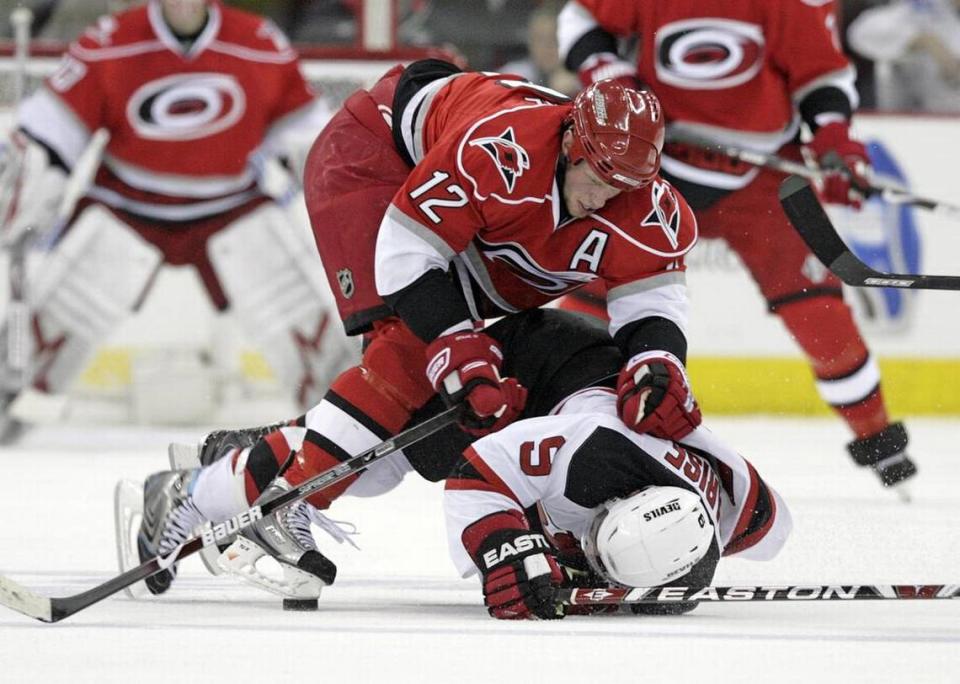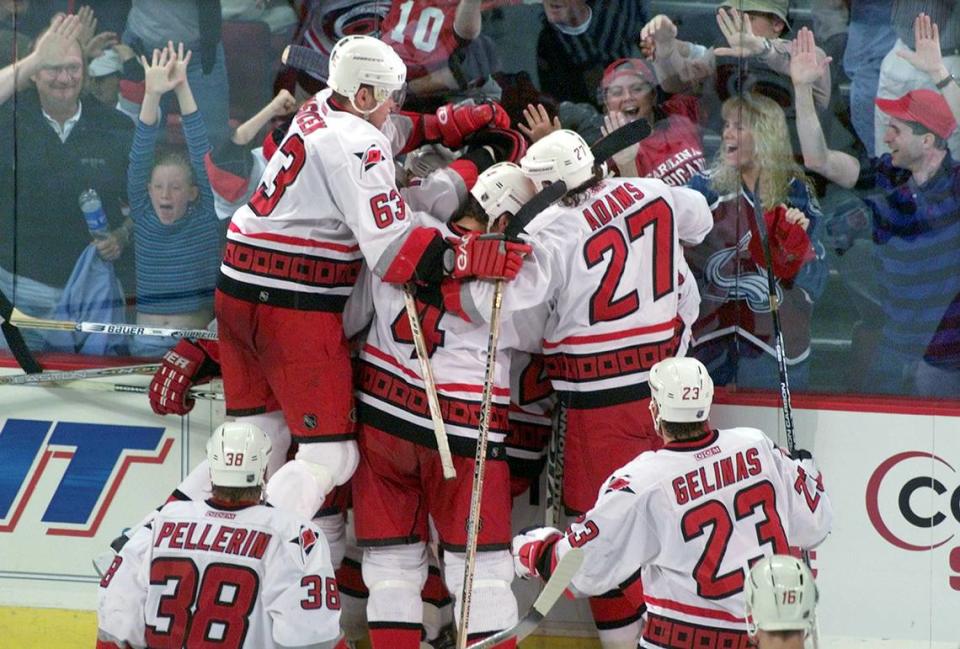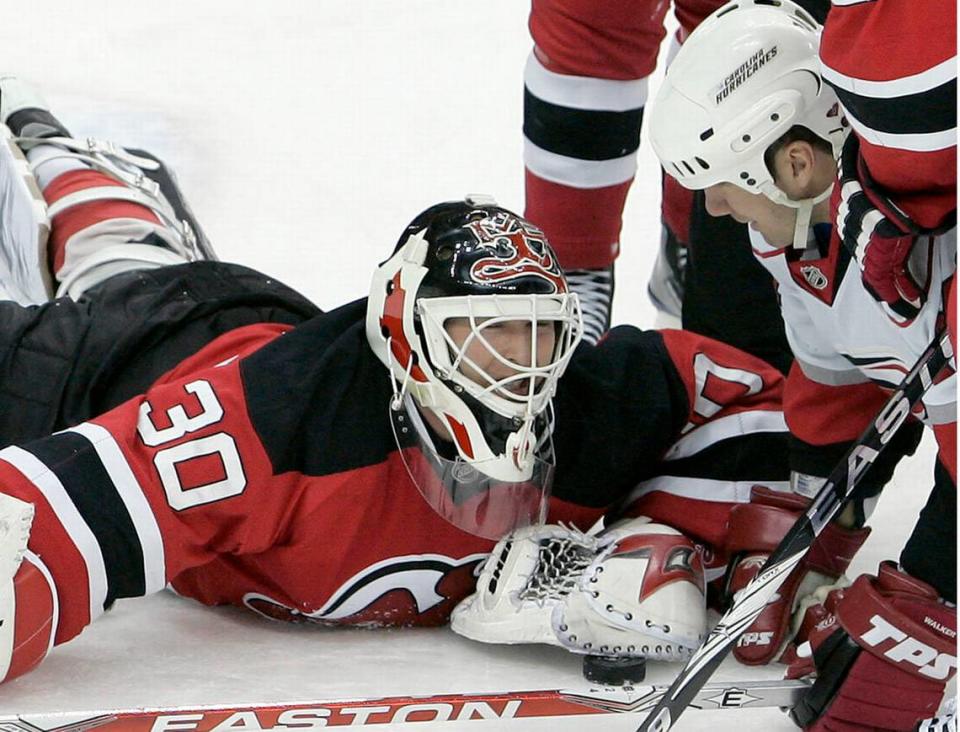Why the Hurricanes wouldn’t be what they are today without the New Jersey Devils
- Oops!Something went wrong.Please try again later.
- Oops!Something went wrong.Please try again later.
- Oops!Something went wrong.Please try again later.
- Oops!Something went wrong.Please try again later.
So the Carolina Hurricanes are playing the New Jersey Devils again.
So what?
It’s been 14 years since the last time they met in the playoffs, and those four epic confrontations in a nine-year span might as well be World War II carrier battles in the South Pacific for all the relevance they have for fans today, the youngest of which weren’t even born when Scott Stevens knocked Shane Willis and Ron Francis out of the same playoff series with hits that were uncannily similar to Jacob Trouba’s demolition of Timo Meier on Sunday, albeit far more destructive.
Yeah, the dude on the pregame show and the general manager of the Kraken. Same guys.
But it matters. It all matters. The Devils played as important a role in the growth of the Hurricanes in this market as anything. They were the foil, the first real rival, the measuring stick, the titan that had to fall for the Hurricanes to rise.
So much of Hurricanes history is tied to the Devils, and not just that the Hurricanes beat them three straight times, but how they did it.
It’s time for a history lesson, on why this is long overdue, and why the Hurricanes wouldn’t be the Hurricanes without the Devils.

Where it all began
It all starts in 2001, when PNC Arena was still the Entertainment and Sports Arena, and the future of NHL hockey in the Triangle was a tenuous proposition indeed. The Hurricanes had played a Halloween game the previous fall against the Tampa Bay Lightning in front of a few hundred people. The embarrassment of Greensboro wasn’t that far behind them. Paul Maurice was annually the first name on the “first coaches to be fired” lists.
The Hurricanes squeaked into the playoffs on the final day of the season. The Devils were a powerhouse, the defending Stanley Cup champions, the model franchise of the Dead Puck Era. It wasn’t supposed to even be a contest. And for three games, it wasn’t. Stevens caught Willis, who scored 20 goals as a rookie that season, coming through the neutral zone and sent him spinning to the ice, ending his season.
In Game 3, the first playoff game at the ESA — those 1999 games against the Boston Bruins were in Greensboro — Stevens caught Francis along the boards with an innocuous-looking hit that nevertheless left Francis crawling shakily back to the bench, ending his season. The series was, in effect, over. Except it wasn’t.

Down 3-0, the Hurricanes fought in Game 4. Finesse defenseman Sandis Ozolinsh, the least-likely candidate, fought Stevens in Game 4, one of many as the fed-up Hurricanes let their frustration flow. They played the Devils even between the whistles, too, forcing overtime, where Rod Brind’Amour tipped a Sami Kapanen shot past Martin Brodeur to send the series back to the Meadowlands — where the Hurricanes won again, to bring hope and a Game 6 home.
The Devils, champions that they were, snuffed out that hope quickly, but for the final minute of regulation, a sold-out arena — something that wasn’t true for games 3 and 4 — rose in unison and gave the Hurricanes a standing ovation for their effort. Brind’Amour would later say that was the moment when he believed hockey could work here, and it led directly to him re-signing that fall and … everything else that followed.
The tide turns
That included the Hurricanes’ revenge in 2002, when Francis, of all people, scored the only goal in Game 6 to eliminate the Devils in the first round, thanks in part to an unexpected switch in goal from Arturs Irbe to Kevin Weekes, on their way to the Stanley Cup finals and a five-game loss to the powerful Detroit Red Wings. If fighting back against the Devils gave the Hurricanes hope in 2001, beating them legitimized them in 2002.
The Hurricanes were able to beat Brodeur in that series. When they played the Devils again in 2006, they drove him crazy. After a 6-0 win in Game 1 that saw Brodeur yanked from the net, Eric Staal forced overtime in Game 2 at what was by then the RBC Center when lockdown Devils center John Madden won a faceoff too well after what looked like the Devils’ game-winning goal, pulling the puck into his own end where Ray Whitney set up Staal.
That five-game series was the least competitive the Hurricanes and Devils have played, and for good reason: The Hurricanes were on to bigger and better things. The first-round series three years later was the most competitive, including a stick-throwing Brodeur tantrum after he thought he was interfered with as the Hurricanes scored the winner with less than a second left in Game 4.
But that series is remembered for The Shock at the Rock, the Hurricanes’ Game 7 comeback at Newark’s Prudential Center. Down 3-2, the Hurricanes beat Brodeur twice in the final 80 seconds — Staal scoring the winner with 32 seconds to play — to turn the end of their season into a trip to Boston. (Some stuff happened there, too, but that’s a story for another day.)

Both Brodeur and Brind’Amour played in all four series, but they’re both still around. Brodeur, now a key member of the Devils’ front office, was the greatest goalie of his generation, one of the best of all time, and the Hurricanes absolutely had his number. Brind’Amour you know. Strange game.
So while some of this may feel like ancient history, it’s essential to making the Hurricanes what they are now. Each series in its own way captures something that’s inextricable from what the Hurricanes have now become, in their maturity as a franchise. They have very little in common with the Devils, but for a decade their fates were intertwined, as if the Hurricanes couldn’t move forward without the Devils in their way.
So, the Devils, again? It may have been 14 years, but this particular matchup tends to portend seminal moments in Hurricanes history. Maybe the question isn’t, “So, the Devils, again?” but, “What took so long?”
Never miss a Luke DeCock column. Sign up at tinyurl.com/lukeslatest to have them delivered directly to your email inbox as soon as they post.
Luke DeCock’s Latest: Never miss a column on the Canes, ACC or other Triangle sports

